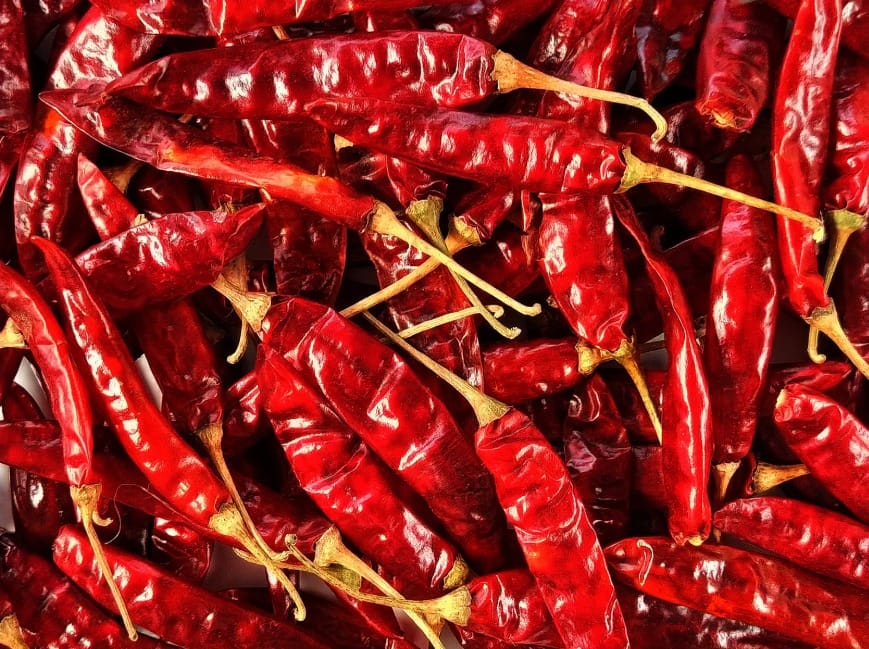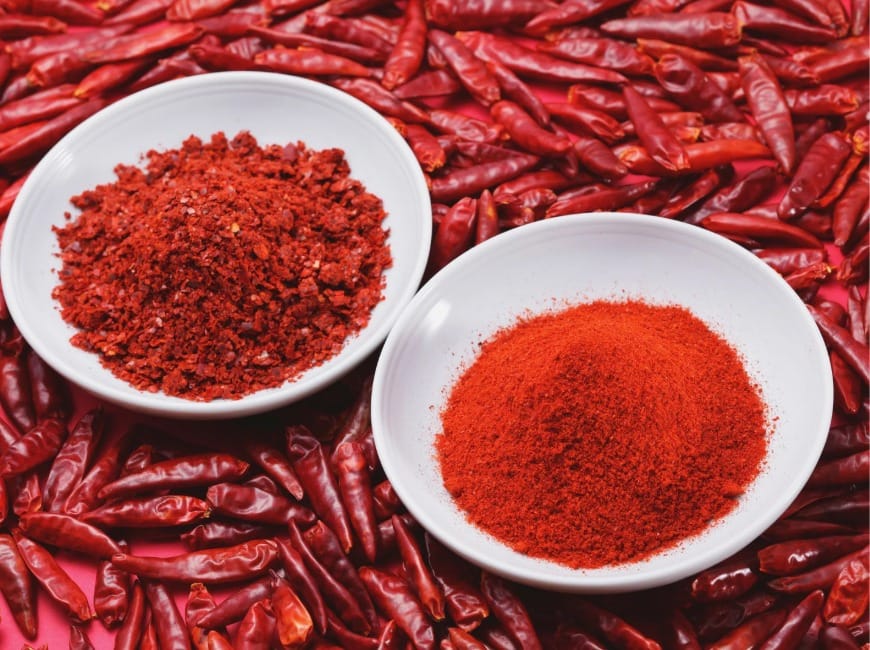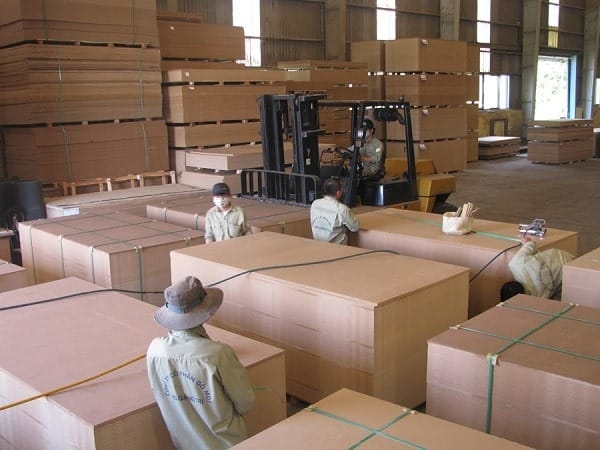Dried chili powder is a high-value spice product, widely popular in the global market due to its convenience and diverse culinary applications. To produce dried chili powder not only retains the characteristic flavor but also meets the requirements of export dried chili standards, strict requirements of demanding markets, requiring a tightly controlled production process from raw material selection, processing to packaging. This article Viot Minh Trang will guide how to make dry chili powder International standard, high quality dried chili powder making method, ensuring competitive products and acceptance with in the permitted range
Choose quality fresh chili
The foundation of high-quality dried chili powder lies in the selection of excellent raw fresh chili peppers. This is the first and most important step, directly affecting the color, flavor, spiciness and hygiene safety of the finished product.
Choosing chili varieties
Choosing the right chilli variety is very important. Priority should be given to varieties known for their beautiful colour (natural bright red), consistent Scoville Heat Units (SHU) and characteristic flavour, which meet the tastes of the target export market.
For example, some markets favor highly spicy chili powders for use in bold-flavored dishes, while others seek out sweet paprika with its vibrant color and milder flavor for adding color and aroma to dishes.
Ripeness and condition
Fresh chillies should be harvested at optimum biological maturity, which is when the fruit is uniformly bright red and plump. Absolutely remove any fruit that is diseased, bruised, rotten, or shows signs of mold.
Underripe (green) or damaged chili will reduce the quality of color, flavor, and especially increase the risk of mycotoxins during drying and storage, seriously affecting the shelf life and safety of the finished chili powder.

Ripeness and condition
Origin and traceability
To ensure safety and compliance with international regulations, priority should be given to purchasing chili from certified growing areas that apply good agricultural practices (GAP) standards such as VietGAP or GlobalGAP.
This not only ensures clean raw materials, minimizes pesticide residues (MRLs) and heavy metals, but also helps establish a clear traceability system.
The chili export business A reputable company like VIOT Minh Trang often has a strict process of controlling the origin of raw materials, making it easy to identify and handle any problems that arise in the supply chain.
Sorting and preliminary cleaning
Immediately after harvest, fresh chillies need to be sorted manually or by machine to remove substandard fruits (uneven size, defective, immature, or damaged). Next, the chillies are thoroughly washed with clean water or a specialized cleaning solution to remove sand, dirt, impurities, and microorganisms on the surface.
This cleaning process is an important step to ensure hygiene before moving on to the next processing stages.
See now:
Instructions on how to make pickled chili at home
3 Suitable drying techniques to achieve export quality
Drying is a key step, directly determining the sensory quality, nutrition, storage time and especially the hygiene safety of dried chili before being ground into powder.agricultural drying methodsConformance is vital for products to meet strict export standards.
Convection circulation drying
This is one of the most popular and effective industrial drying methods for producing dried chili for export. In this method, hot air (usually at room temperature)50-70°C) is blown and circulated evenly throughout the drying chamber by a fan system. This mechanism ensures that temperature and humidity are evenly distributed, helping the chili to dry quickly, avoiding uneven drying or local overheating that can alter color and flavor. Convection drying also takes place in a closed environment, minimizing contamination from the outside.
Freeze drying
For high-grade chili peppers, chili peppers with high essential oil value, or when you want to keep the natural color and fresh flavor of the chili pepper to the maximum, the freeze-drying method (drying at low temperature, usually below 40°C) is given priority.
Although the investment and operating costs are higher, freeze-drying minimizes the evaporation of flavor and color compounds, optimally preserving the nutritional and sensory values of chili peppers.
Humidity control
Regardless of which drying method is used, the ultimate goal is to achieve a uniform and safe moisture content for the peppers, usually under 10-12%. For demanding markets or those requiring long storage times, moisture content may need to be even lower, for example below 8%. Continuous monitoring of moisture content during and immediately after drying is important to ensure export dried chili standards and maintain stable product quality, prevent re-humidification and mold growth.

Humidity control
See now:
Summary of the hottest peppers in vietnam
Converting Dried Chili into Powder: Critical Stages to Achieve Quality Standards
Once the chili has been completely dried and reached the required moisture content, in order to obtain a high-quality, uniform and high-quality dried chili powder that meets strict standards, the chili needs to go through a processing procedure that includes careful grinding and screening stages. This process, also known as how to make dry chili powder or how to make dried chiliIn industry, it is not just a matter of grinding, but a series of tightly controlled steps to optimize the flavor, color and purity of the product. Each of the following stages plays a key role in ensuring that the final chili powder meets export standards.
Preliminary grinding
After drying, the dried chillies are fed into a coarse grinder (also known as a crusher or coarse cutter). This stage plays an important role in breaking down the original structure of the chillies into smaller pieces, preparing for the next more efficient fine grinding process. Preliminary grinding helps reduce the load on the fine grinder, saving energy and increasing productivity. At the same time, this is also an opportunity to remove unwanted parts such as hard chili stems, not completely dry chili seeds, or any large impurities that may remain after previous processing steps, ensuring clean raw materials before entering fine grinding.
Fine grinding (Powder making)
The coarsely ground dried chili flakes are then transferred to a specialized fine grinder, such as a hammer mill, a pin mill or an industrial superfine grinder. This is the core stage for converting chili into powder. The fineness of the chili powder (particle size) can be flexibly adjusted by changing the screen size of the grinder. This depends on the specific requirements of the import market and the intended use (for example, chili powder used as a direct spice for dishes often requires a higher fineness than chili powder used as an ingredient in the production of processed foods). During the fine grinding process, temperature control is extremely important. Excessively high temperatures due to friction can significantly reduce the natural color, characteristic flavor and capsaicin content (the spicy substance) of chili, directly affecting the sensory quality and product value.
Sieve
After being finely ground, the chili powder is passed through an industrial sieve or screening system. The main purpose of this stage is to classify and ensure that the powder has a uniform, smooth particle size, while completely removing any coarse particles, lumps, or unwanted tiny impurities left over from the grinding process. The sieving/screening process helps the chili powder have a smooth, fluffy texture, uniform color, and high purity. This is the final step to complete the product, ensuring that the chili powder meets the strict requirements of the market in terms of appearance and quality.dried chili for export, ready for packaging and storage.

Sieve
Tips for maintaining export quality
To ensure that exported dried chillies maintain superior quality and meet all international standards, chillies exporting businesses need to apply a series of strict control measures from post-processing to delivery. This requires special attention to each important aspect such as strict hygiene practices, post-drying moisture, packaging, periodic inspection, etc., which we will go into detail below:
Strict sanitation practices (GMP)
Compliance with Good Manufacturing Practices (GMP) is fundamental to product safety and quality. This includes regular cleaning and disinfection of all equipment, machinery, and buildings. Effective pest and rodent control and waste disposal procedures must also be implemented.
At the same time, all employees involved in the production process must strictly adhere to personal hygiene rules, thereby minimizing the risk of cross-contamination and ensuring that the production environment always meets food safety standards.
Control humidity after drying
Even after drying, chili powder can still absorb moisture from the air. Therefore, it is necessary to store the product in a cool, dry place with controlled humidity (usually below 60% RH). It is important to use packaging materials with high moisture resistance, such as multi-layer PE bags or packaging with an inner aluminum layer.
The target moisture content of the finished chili powder should be maintained under 8-10%to prevent the growth of mold and bacteria, preserving product quality during storage and transportation.
Pack
The packaging process must be carried out in a clean environment, in compliance with food safety regulations. Use packaging materials that meet food safety standards, capable of protecting chili powder from moisture, light, oxygen and physical impacts.
For some markets, vacuum packaging or nitrogen flushing can be applied to remove oxygen, which significantly extends shelf life by slowing oxidation.
Export packaging specifications must also strictly comply with the requirements of each import market (e.g. on material type, net weight, labeling information).

Export packaging specifications
See now:
Discover the spicyness of vietnamese chili: Are Vietnamese chili the spiciest?
Periodic quality control
Before leaving the factory, each batch of dried chili powder must undergo a comprehensive quality control process at internationally recognized laboratories (e.g. ISO 17025). The testing criteria include:
- Physical parameters:Color, grain size, impurity content (soil, sand, metal, foreign plant impurities).
- Chemical parameters:Humidity, pungency (SHU), volatile oil content (aroma).
- Microbiological parameters:Total aerobic bacteria, Coliforms, E.coli, Salmonella, yeasts and molds.
- Pollutant analysis:Pesticide Residue Limits (MRLs) as regulated by the importing country, heavy metal content (Lead, Cadmium, Arsenic), and especially the mycotoxin Aflatoxin. Exceeding any of the limits may result in the shipment being rejected.
Traceability system
Building and maintaining a robust traceability system is a requirement for many major markets. This system allows importers and authorities to easily track all information about a shipment, from the place of cultivation, harvest date, processing, production date, expiry date, to test results.
This enhances consumer confidence and transparency in the supply chain, while allowing for a quick and effective response should quality issues arise.
Comply with international certifications
To demonstrate our capacity and commitment to quality,chili export businessIt is necessary to apply and achieve valuable international certifications. Popular certifications include ISO 22000 (food safety management system), HACCP (hazard analysis and critical control points), GMP (good manufacturing practice), and market-required certifications such as BRC (Global Standard for Food Safety), Halal, Kosher.
These certifications are not only “passports” but also proof of professional production processes and superior product quality.
By meticulously following these steps and maintaining strict quality control measures, manufacturers can ensure their dried chili powder meets or exceeds export dried chili standards, opening the door to potential international markets and contributing to enhancing the reputation of Vietnamese agricultural products.
In short, to produce dried chili powder that meets export standards, businesses need a comprehensive process that not only stops at techniques but also has an absolute commitment to quality and food safety. From selecting fresh ingredients, applying advanced drying and grinding methods, to strict quality control and compliance with all international regulations, every step is key. Thanks to the attention to detail and synchronous investment in the quality management system, units such as VIOT Minh Trang has been successful in bringing high quality Vietnamese dried chili powder products to the world market, contributing to affirming and enhancing the value of Vietnamese agricultural products.





Tác giả Tưởng Mạnh Biên
Là chuyên gia giàu kinh nghiệm trong lĩnh vực xuất khẩu nông sản. Với nhiều năm làm việc, nghiên cứu và trực tiếp tham gia vào các hoạt động sản xuất, kinh doanh và xuất khẩu nông sản, tác giả chia sẻ những kiến thức chuyên môn sâu sắc cùng các bài học thực tiễn giá trị nhằm hỗ trợ doanh nghiệp.
- Địa chỉ: Số 27, Tổ 23, Lĩnh Nam, Hoàng Mai, Hà Nội
- Email: viotvietnam.vn@gmail.com
- SĐT: 0977 728 269